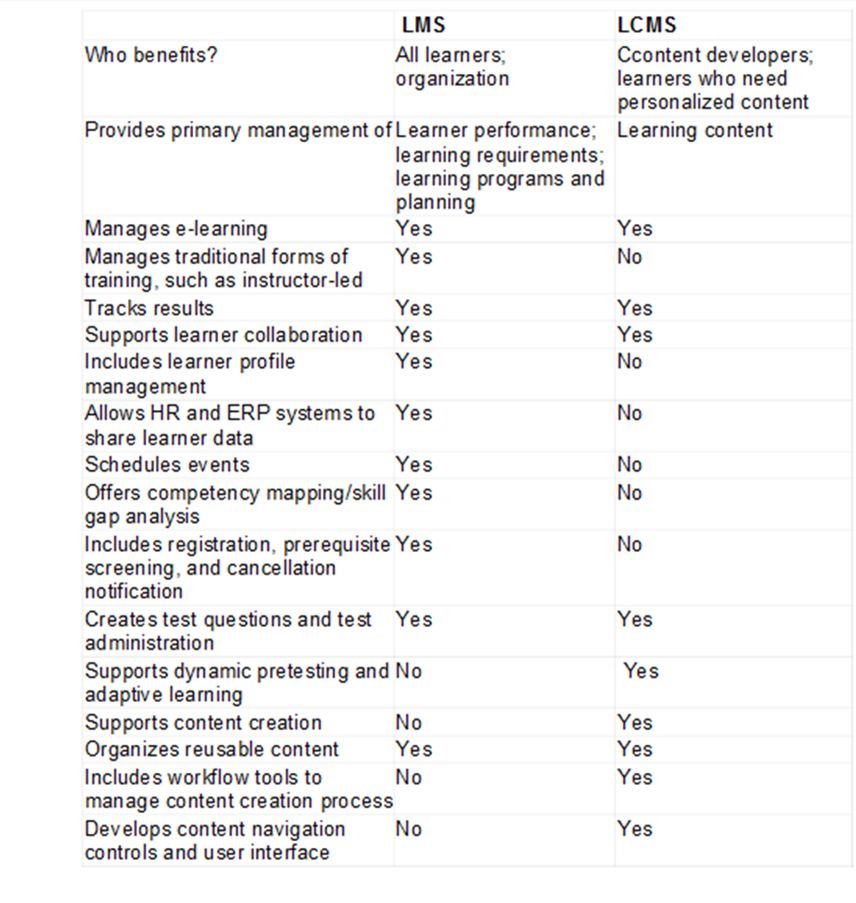Below is an extract of the original article by Leonard Greenberg
If you’re confused about the differences between a learning management system (LMS) and a learning content management system (LCMS), you’re not alone. Not only are the names similar, some suppliers are positioning LCMSs as the new wave of LMSs. In fact, an LMS and an LCMS are complementary but very different systems that serve different masters and address unique business challenges.
In essence, an LMS is a high-level, strategic solution for planning, delivering, and managing all learning events within an organization, including online, virtual classroom, and instructor-led courses. The primary solution is replacing isolated and fragmented learning programs with a systematic means of assessing and raising competency and performance levels throughout the organization. For example, an LMS simplifies global certification efforts, enables companies to align learning initiatives with strategic goals, and provides a viable means of enterprise-level skills management. The focus of an LMS is to manage learners, keeping track of their progress and performance across all types of training activities. It performs heavy-duty administrative tasks, such as reporting to HR and other ERP systems but isn’t generally used to create course content.
In contrast, the focus of an LCMS is on learning content. It gives authors, instructional designers, and subject matter experts the means to create e-learning content more efficiently. The primary business problem an LCMS solves is to create just enough content just in time to meet the needs of individual learners or groups of learners.
Rather than developing entire courses and adapting them to multiple audiences, instructional designers create reusable content chunks and make them available to course developers throughout the organization. This eliminates duplicate development efforts and allows for the rapid assembly of customized content.
How does an LCMS fit within an LMS infrastructure?
Because an LMS can have a direct impact on the work of thousands of learners and manages all aspects of organizational learning, experts recommend starting with an LMS that can be easily integrated with an LCMS.
IDC’s report : The Learning Content Management System: A New E-Learning Market Segment Emerges explains: “LCMSs and LMSs are not only distinct from one another, they also complement each other well. When tightly integrated, information from the two systems can be exchanged, ultimately resulting in a richer learning experience for the user and a more comprehensive tool for the learning administrator. An LMS can manage communities of users, allowing each of them to launch the appropriate objects stored and managed by the LCMS. In delivering the content, the LCMS also bookmarks the individual learner’s progress, records test scores, and passes them back to the LMS for reporting purposes.”
Differences and overlap
Both an LMS and an LCMS manage course content and track learner performance.
Both tools can manage and track content at a learning object level, too. An LMS, however, can manage and track blended courses and curriculum assembled from online content, classroom events, virtual classroom meetings and a variety of other sources. Although an LCMS doesn’t manage blended learning, it does manage content at a lower level of granularity than a learning object, which allows organizations to more easily restructure and repurpose online content. In addition, advanced LCMSs can dynamically build learning objects based on user profiles and learning styles. When both systems adhere to XML standards, information is passed easily from the object level to the LMS level. The following chart, based primarily on research conducted by Brandon Hall, summarizes the capabilities and differences between the two systems:
For more, please refer to the original article



